Introduction
Mid Term finance serves as a critical financial bridge, addressing funding needs that fall between short-term and long-term horizons. This category of financing typically involves repayment periods ranging from one to five years. Businesses often turn to mid-term financing to fund projects, expansions, or capital investments that require a more extended repayment period than short-term options offer. It strikes a balance between immediate liquidity concerns and long-term strategic goals, providing flexibility for businesses to meet medium-range financial requirements efficiently. Various financial instruments, such as term loans and equipment financing, are commonly employed to secure mid-term financing.
What Is Mid Term Finance?
Mid-term finance refers to a category of financial arrangements with a repayment period falling between short-term and long-term durations, typically spanning from one to five years. It serves as a crucial funding option for businesses seeking capital to support projects or investments that extend beyond the immediate horizon but do not require the lengthy commitment associated with long-term financing.
Mid-term finance allows businesses to strike a balance, providing flexibility to address medium-range financial needs efficiently. It is commonly used for initiatives such as equipment purchases, technology upgrades, or business expansions. The repayment terms are more extended than those of short-term options, offering businesses a structured timeframe to repay the borrowed funds.
Financial instruments employed for mid-term financing include term loans, which come with fixed interest rates and a predefined repayment schedule. This type of financing provides businesses with the necessary resources to pursue strategic initiatives and capitalize on growth opportunities without committing to the extended timeframes associated with long-term loans. As such, mid-term finance plays a pivotal role in supporting businesses in their efforts to balance short-term liquidity concerns with long-term strategic goals.
Who Are the Users of Mid Term Financing?
The users of mid-term financing are typically businesses and organizations across various industries. These entities leverage mid-term financing to address specific financial needs that fall between short-term and long-term requirements. Here are some common users of mid-term financing.
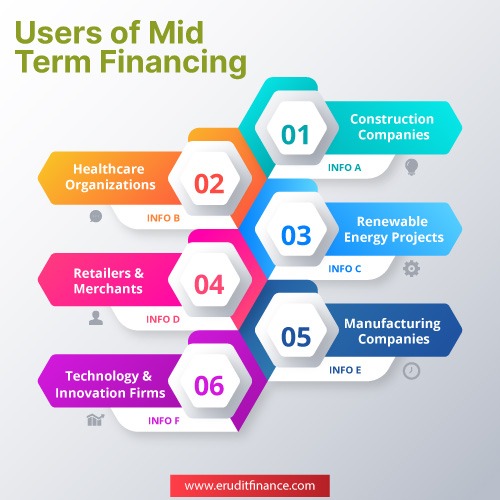
1). Small and Medium-sized Enterprises (SMEs): SMEs often utilize mid-term financing to fund equipment purchases, technology upgrades, or expansion projects that require a longer repayment period than short-term options provide.
2). Manufacturing Companies: Businesses involved in manufacturing may opt for mid-term financing to acquire machinery and equipment essential for production, with a repayment period that aligns with the useful life of the assets.
3). Technology and Innovation Firms: Companies in the technology sector frequently use mid-term financing to fund research and development initiatives, acquire technology infrastructure, or implement upgrades to stay competitive.
4). Retailers and Merchants: Retail businesses may turn to mid-term financing for initiatives such as store expansions, renovations, or the purchase of inventory systems, allowing them to enhance and grow their operations.
5) Healthcare Organizations: Hospitals and healthcare facilities may use mid-term financing to invest in medical equipment, facility expansions, or technology upgrades to improve patient care and services.
6). Construction Companies: Construction firms often require mid-term financing to fund projects that have a longer duration than short-term financing options can accommodate, such as building construction or infrastructure development.
7). Transportation and Logistics Companies: Businesses in the transportation sector may utilize mid-term financing to acquire or upgrade vehicles, invest in logistics technology, or expand their fleet capacity.
8). Renewable Energy Projects: During this period, companies planning for these projects may seek mid-term financing where they finance the cost of constructing the project.
The above examples indicate that mid-term financing is flexible and can be used within different types of companies or industry sectors. This method has a balanced approach and provides a structured repayment plan for projects that have timelines longer than short-term solutions while are still shorter compared to long-term funding.
What Is the Difference Between Short and Medium Term Finance?
The primary differences between short-term and medium-term finance lie in the duration of the financial arrangements, the nature of the financial instruments used, and the purposes they serve for businesses.
| Short-Term Finance | Medium-Term Finance | |
| Duration | Typically involves financial arrangements with a repayment period ranging from a few days to one year. Used to address immediate operational needs, working capital requirements, and short-term fluctuations in cash flow. | Encompasses financial arrangements with a repayment period typically ranging from one to five years. Designed for funding projects, capital investments, and initiatives that extend beyond the immediate horizon but do not require the extended commitment associated with long-term financing. |
| Financial Instruments | Involves financial instruments designed for quick access and immediate needs. Examples include bank overdrafts, trade credit, commercial papers, and short-term loans. | Utilizes financial instruments structured for longer repayment periods and more extended commitments. Examples include term loans, equipment financing, and mid-term loans. |
| Purpose | Used for addressing day-to-day operational expenses, managing working capital, and covering short-term obligations. Suited for situations where quick access to funds is essential, such as seasonal variations or unexpected expenses. | Employed for funding projects, expansions, equipment purchases, or capital investments that require a more extended repayment period than short-term options. Provides businesses with flexibility to address medium-range financial needs efficiently. |
| Risk and Cost: | Generally associated with lower interest rates but may incur higher costs due to frequent renewals and refinancing. Subject to market fluctuations and refinancing risks. | Involves higher interest rates compared to short-term financing but provides stability and predictability in terms of interest payments. Lower refinancing risks and exposure to short-term market volatility. |
Summing the matter up, short-term credit is designed for short-run purposes that are required immediately and need repaying in a shorter time frame than is appropriate for medium-term finance. This type of financing helps companies cover the middle part linking short- and long-term periods Which one to choose depends on the kind of financial problem needed by the business, the company’s strategies, as well as attitude toward risk.
What Is Medium Term Finance Used For?
Businesses use medium-term finance to meet certain financial needs that are not short-term or long-term. The use of medium-term finance changes, serving different needs based on the goals and situation of the business. Look at these typical uses of medium-term finance.
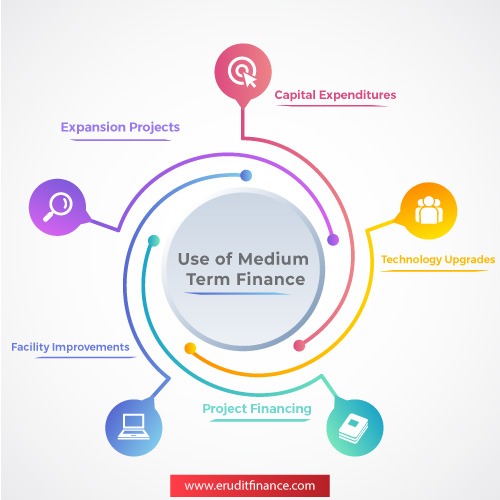
| Capital Expenditures: Companies can use the funding for a moderate duration to cover costs of big purchases like machines, tech stuff, or gear. This lets them put money into things that boost the way they work and stand out from the crowd. |
| Expansion Projects: Medium-term finance supports business expansion initiatives, such as opening new locations, entering new markets, or launching additional product lines. It provides the necessary capital for growth without committing to the extended timeframes associated with long-term financing. |
| Technology Upgrades: Companies often utilize medium-term financing to invest in technology upgrades. This may include adopting new software systems, enhancing IT infrastructure, or implementing innovations to stay competitive in the market. |
| Facility Improvements: Medium-term finance can be used for renovations or improvements to business facilities. This includes refurbishing offices, updating manufacturing facilities, or enhancing retail spaces. |
| Project Financing: Businesses engaged in specific projects, such as construction or development initiatives, may secure medium-term financing to fund these endeavors. This ensures a structured repayment period aligned with the project’s timeline. |
| Inventory Management: Medium-term finance supports businesses in optimizing inventory management. It provides the capital needed to invest in inventory systems, manage stock levels effectively, and adapt to fluctuations in demand. |
| Debt Refinancing: Companies may use medium-term financing to refinance existing debts, consolidating multiple obligations into a single, more manageable repayment structure. This can improve cash flow and reduce overall debt service costs. |
| Working Capital Management: Medium-term financing can contribute to working capital management by providing businesses with a structured approach to address medium-range financial needs. This includes managing receivables, and payables, and maintaining sufficient liquidity. |
| Vehicle Fleet Expansion: Businesses in transportation or logistics may use medium-term financing to expand or upgrade their vehicle fleets. This ensures they have the necessary resources to meet increasing demand or improve operational efficiency. |
In essence, medium-term finance is a versatile tool that businesses leverage for initiatives requiring a more extended repayment period than short-term options offer, without committing to the extensive timeframes associated with long-term financing. It provides a balanced approach to address medium-range financial requirements efficiently.
Medium Term Sources of Finance Advantages and Disadvantages
Advantages of Medium Term Sources of Finance
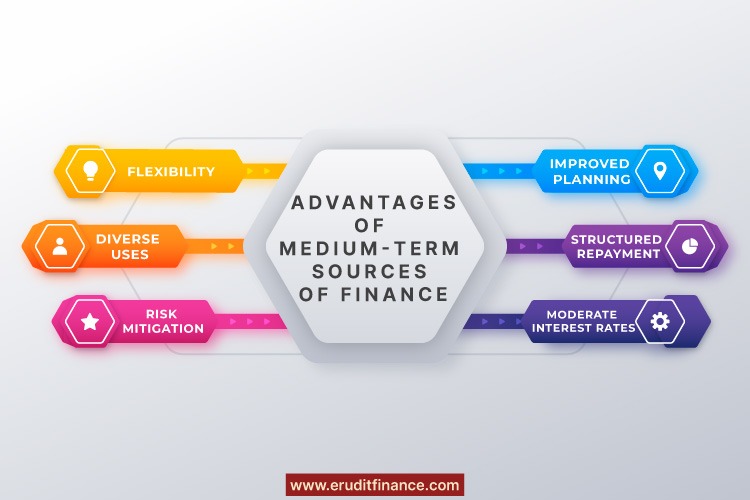
Structured Repayment- Medium-term financing offers a structured repayment schedule, providing businesses with a clear framework for meeting financial obligations.
Flexibility- It strikes a balance between short-term and long-term financing, offering businesses the flexibility to address medium-range financial needs efficiently.
Moderate Interest Rates- Interest rates for medium-term financing are typically more moderate than short-term options, providing businesses with cost-effective borrowing.
Diverse Uses- Medium-term finance can be utilized for a variety of purposes, including capital expenditures, expansion projects, technology upgrades, and working capital management.
Risk Mitigation- The moderate repayment period reduces the risks associated with short-term refinancing and provides stability compared to longer-term commitments.
Improved Planning- Businesses can plan and execute strategic initiatives with more precision, as the structured repayment allows for better alignment with project timelines.
Disadvantages of Medium-Term Sources of Finance
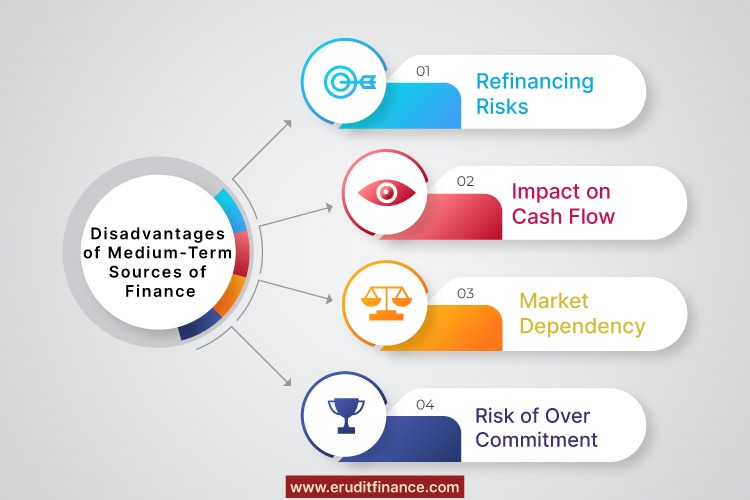
Higher Interest Rates than Long-Term Financing- Borrowing money for a medium time usually has bigger interest rates than longer-time loans. This could make it more expensive to borrow in total.
Refinancing Risks- There is a risk of refinancing challenges, especially if market conditions or the financial health of the business changes during the repayment period.
Limited for Long-Term Projects- While more flexible than short-term financing, medium-term sources may still be insufficient for very long-term projects or investments.
Asset Collateral Requirements- Some medium-term financing options may require businesses to provide assets as collateral, limiting flexibility for companies with fewer tangible assets.
Impact on Cash Flow- Regular repayments can impact cash flow, especially if the business faces unexpected financial challenges or variations in revenue.
Market Dependency- Medium-term financing is subject to market conditions, and businesses may be affected by changes in interest rates or the availability of financing options.
Risk of Overcommitment- In some cases, businesses may be tempted to overcommit to medium-term financing, potentially leading to financial strain if circumstances change.
Limited for Short-Term Needs- While more extended than short-term financing, medium-term sources may not be ideal for addressing very immediate or short-term financial needs.
Understanding these advantages and disadvantages helps businesses make informed decisions about the use of medium-term financing, ensuring it aligns with their strategic goals and financial circumstances.
What Are the Characteristics of Medium Term Finance?
a). Duration: Medium-term finance typically involves a repayment period that falls between short-term and long-term, spanning from one to five years.
b). Purpose: It is utilized for funding projects, capital expenditures, and business initiatives that extend beyond the immediate horizon but do not require the extended commitment associated with long-term financing.
c). Financial Instruments: Medium-term finance employs various financial instruments such as term loans, equipment financing, and mid-term loans designed for a more extended repayment period.
d). Structured Repayment: Medium-term financing provides a structured repayment schedule with regular installment payments. This structure facilitates better financial planning for businesses.
e). Interest Rates: Interest rates for medium-term finance are generally moderate, falling between the lower rates of long-term financing and the higher rates associated with short-term options.
f). Flexibility: It offers businesses a balanced and flexible approach to addressing medium-range financial needs, allowing for adaptation to changing circumstances.
g). Risk Mitigation: Compared to short-term financing, medium-term financing helps mitigate risks associated with frequent refinancing. It provides stability while offering more flexibility than long-term commitments.
h). Use Cases: Businesses use medium-term finance for a variety of purposes, including capital expenditures, technology upgrades, expansion projects, and working capital management.
i). Collateral Requirements: Some medium-term financing options may require businesses to provide collateral, which can include assets like machinery or equipment.
j). Market Dependency: Medium-term financing is subject to market conditions, and businesses may be affected by changes in interest rates or the availability of financing options.
k). Balance between Cost and Commitment: It strikes a balance between the lower cost of short-term financing and the longer-term commitment associated with higher-cost long-term financing.
l). Impact on Cash Flow: Regular repayments associated with medium-term finance can impact cash flow, and businesses need to manage these obligations to ensure liquidity.
m). Suitability for Strategic Initiatives: Medium-term financing is particularly suitable for businesses engaging in strategic initiatives that require a more extended repayment period than short-term options provide.
Understanding these characteristics helps businesses evaluate whether medium-term finance aligns with their specific financial needs, strategic goals, and risk tolerance. It provides a valuable tool for businesses seeking a structured yet flexible approach to financial management.
What Is the Importance of Medium Term Finance?
The importance of medium-term finance lies in its unique role as a financial tool that addresses specific needs and challenges faced by businesses. Here are key aspects highlighting the importance of medium-term finance.
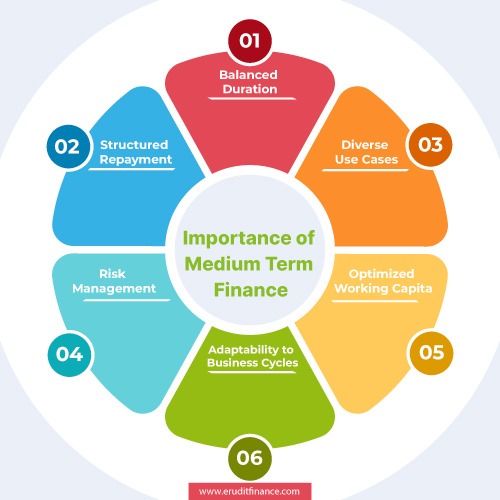
Balanced Duration- Medium-term finance strikes a balance between short-term and long-term financing, offering businesses a duration that aligns with projects or initiatives that extend beyond immediate needs but do not require lengthy commitments.
Flexibility for Strategic Initiatives- It provides businesses with the flexibility to pursue strategic initiatives, such as capital expenditures, technology upgrades, or expansion projects, without committing to the extended repayment periods associated with long-term financing.
Structured Repayment- Medium-term finance offers a structured repayment schedule with regular installments. This predictability aids businesses in financial planning and management.
Cost-Effective Borrowing- While interest rates for medium-term financing are generally higher than short-term options, they remain more moderate than long-term financing, offering a balance between cost and commitment.
Mitigation of Refinancing Risks- Medium-term finance helps mitigate risks associated with frequent refinancing, which is common in short-term financing. This stability contributes to better risk management for businesses.
Diverse Use Cases- It can be applied to a variety of purposes, making it versatile for businesses. Whether funding capital expenditures, facility improvements, or technology upgrades, medium-term finance adapts to different financial needs.
Support for Business Growth- Medium-term financing supports businesses in their growth endeavors by providing the necessary capital for expansions, acquisitions, and other initiatives that contribute to increased market presence.
Optimized Working Capital- Businesses can use medium-term finance to optimize working capital, addressing operational needs that require a more extended repayment period than short-term options offer.
Risk Management- By offering a structured and balanced approach, medium-term finance assists businesses in managing financial risks. It provides a cushion against short-term market fluctuations while avoiding long-term commitment risks.
Asset Acquisition & Upgrades- It enables businesses to acquire or upgrade assets such as machinery, equipment, or technology, contributing to improved operational efficiency and competitiveness.
Adaptability to Business Cycles- Medium-term finance allows businesses to adapt to different phases of the business cycle. It provides the necessary financial support without overcommitting to prolonged obligations.
Enhanced Financial Planning- With a more structured repayment schedule, businesses can enhance their financial planning capabilities, making informed decisions about investments, expenditures, and resource allocation.
In summary, medium-term finance is vital for businesses seeking a financial tool that balances duration, flexibility, and structured repayment. Its importance is evident in its ability to support strategic initiatives, mitigate risks, and contribute to overall financial stability and growth.
Bottomline:-
In conclusion, mid-term finance serves as a crucial financial bridge, offering businesses a balanced solution that aligns with projects and initiatives extending beyond short-term needs. With its structured repayment, moderate interest rates, and adaptability to diverse use cases, mid-term finance enables businesses to pursue strategic growth, optimize working capital, and manage financial risks effectively. This versatile source of funding strikes a harmonious balance between short-term flexibility and long-term commitment, empowering businesses to navigate their financial landscape with resilience and strategic foresight.
Also Read:










